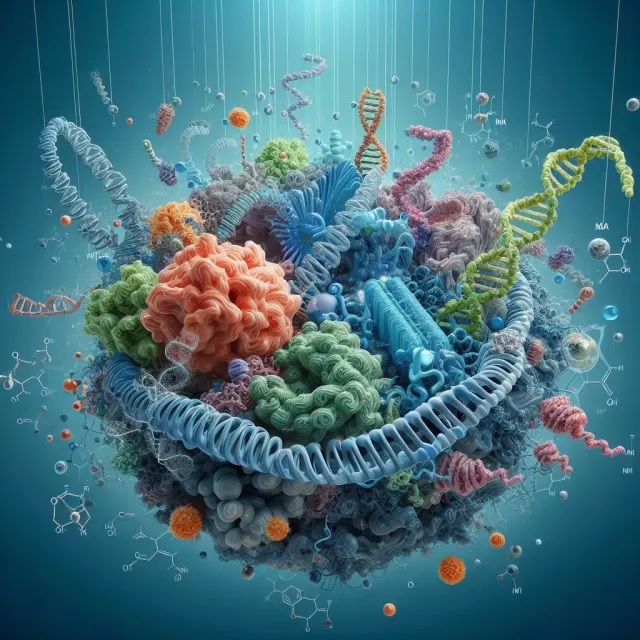Andras Lab
Website of the lab of Professor Peter Andras
Current projects
Algebraic theory of molecular interaction systems
Funding: Edinburgh Napier University - EPSRC DTA
PhD student: Mr Joe Pratt-Johns
The project is about the development of an algebraic theory that can describe and capture systems of molecular interactions that happen within living cells. The project is based on earlier work by Fontana and Buss on lambda-calculus based modelling f chemistry. We are developing a category theory approach to the modelling of molecular interaction systems. The project co-supervisors are: Dr Chris Guiver, Dr Kevin Hughes and Dr Toby St Clere Smithe.
Industrial applications of machine learning
Funding: GE Renewable Energy studentship, 2020 - 2025
PhD student: Mr Walter Lee (Part-time)
The project is about the exploration of a range of machine learnign techniques in the context of engineering applications. In particular we are looking at image processing and image analysis methods and inteligent control algorithms applied to improve the precision control of industrial robots. The project studentship is provided by GE Renewable Energy as funding for part-time tuition fees. The PhD student, Walter Lee, works for GE Renewable Energy while doing the PhD project.
Bioinformatics analysis of the microbiome
Funding: self-funded PhD project, 2019 - 2024
PhD student: Ms Fliss Wainwright (Part-time)
(Part-time)
The project aims to show that the analysis of non-targeted microbiome data (i.e. decoded fragments of DNA / RNA from samples from a particular body part/area, when the purpose of the sampling is not specifically microbiome analysis) can lead to equivalent results as data originating from targeted sampling (i.e. when the sampling is purposfully collected for microbiome analysis). The results will be applied in the context of disease state prediction.
Smart energy systems - privacy preserving distributed machine learning
Joint supervision with Professor Zhong Fan.
Funding: ERDF studentship, 2018 - 2021
PhD student: Mr Chris Briggs
The project is about the use of data analytics techniques in the context of smart energy systems that rely on fog computing infrastructure (i.e. computing resources below the cloud computing level, also known as edge computing). The project is in collaboration with Assured Systems Ltd. In particular we are looking at the development of privacy preserving machine learnign methods and applications in this context.
Machine learning for health care data analytics
Joint supervision with Professor Paul Cool, Robert Jones & Agnes Hunt Orthopaedic Hospital (RJAH) - Oswestry
Funding: self-funded PhD project, 2020 - 2021
PhD student: Mr Jonathan Fisher
The project is about the use of machine learning tools to analyse medical data with the aim to improve support for diagnostic analysis. In particular, we aim to look at bone cancer imaging data (e.g. x-rays, MRI data) and a combination of machine learning tools to build systems that can provide reliable supprot for diagnostic analysis.
Security / usability trade-off in the context of e-government services
Funding: overseas studentship, 2015 - 2019
PhD student: Mr Abdulla Alshamsi
Security and usability are key aspects of services offered over the Internet. They are critically important for the public trust and take-up with respect to e-government services. However there is limited research on the trade-off between these two aspects of e-government services, especially in the context of smart devices that may be used to access these services. This project aims to assess this trade-off through a series of experiments and to establish factors that are key influencers of this trade-off.
Testing large-scale software on the cloud
Funding: overseas studentship, 2015 - 2019
PhD student: Mr Amro Al-Said Ahmad
Large-scale software is difficult to develop, test and maintain. Often it integrates many parts developed by different developers, at different times, and possibly using different programming languages. This project aims to use cloud computing resources to make testing of large-scale software scalable, effective and adaptive.
Past projects
Designing and validating novel voltage sensitive dyes for neuroscience research
Funding: Leverhulme Trust, £178k, 2015-2019.
Collaborator: Prof Andrew Benniston, Newcastle University
Researchers: Dr Dumitru Sirbu (Newcastle), Dr John Butcher (Keele), Dr Jackie Tickle (Keele)

This project aims to develop new voltage sensitive dyes (VSD) for neuro-imaging using the Bodipy molecule as a starting point and rational molecular design as a method for development of new molecules. We assess the toxicity and signal quality for each considered molecule and aim to design a molecule that gives much better signal than current VSD molecules, while also keeping low the neuro-toxicity of the dye molecule. We use the crab stomatogastric ganglion (STG) to test the dye molecules and in the final stage of the project we will test the new dyes on mouse cortical tissue as well.

Textmining for the partial automation of systematic literature reviews in software engineering
Funding: overseas studentship, 2015 - 2018
PhD student: Dr Babatunde Kazeem Olorisade (currently postdoc at the University of Bristol)
(currently postdoc at the University of Bristol)
Systematic reviews are a mainstream tool today in software engineering. However, doing systematic reviews is a very labour intensive process, which offers several opportunities for partial automation. We look at the use of textmining techniques to automate the selection of papers for inclusion in systemtic reviews. We consider a range of machine learnign methods to supprot this. We aim to build a user-friendly tool to support partial automation of software engineering systematic reviews.
Spam filtering for social media
Funding: overseas studentship, 2014 - 2018
PhD student: Dr Mohammed Al-Janabi (currently Lecturer at the University of Baghdad, Iraq)
(currently Lecturer at the University of Baghdad, Iraq)
Spam filtering is an important service for all variants of electronic communications. Spammers on social media are difficult to detect in time. We aim to use a combination of machine learning methods and optimised selection of features to develop a novel spam filtering system for social media.
Functional variability of neurons
Funding: Keele University, 2015 - 2017
PhD student: Ms Filipa Dos Santos
This project aims to investigate the functional variability of neurons and the importance of this in the context of the functionality of the neural circuits to which the neurons belong. It is known that neurons in the hippocampus or the cortex participate in a variable way in the neural circuits and it is assumed that their functionality may change accordingly. However, these neural systems are far too complicated to analyse this aspect of the neural behaviour in fine detail.
We use the crab stomatogastric ganglion (STG) as the model system, and in particualr we look at the behaviour of the two PD neurons in the context of the activity of other neurons belonging to the pyloric rhythm generating circuit. We also use computational modelling to analyse the factors and implications of neural functional variability.

Extracting and managing tacit knowledge
Funding: InnovateUK and KBC Process Technology Ltd, £131k, 2016 - 2017.
Collaborators: Dr Gordon Rugg, Dr Ed de Quincey
Researcher: Ms Amy Martin (KTP Associate)
This project was about developing methods and tools for extraction and representation of tacit and semi-tacit knowledge of senior experts in industrial hydrocarbon processing who work for the industrial partner of the project, KBC Process Technology. The project results are expected to help the training of junior experts and to contribute to new services offered to the clients of the industrial partner.
Machine learning analysis of industrial data to support process optimisation
Funder: KTP, £142k, 2013-2015.
Collaboration: XACT PCB Ltd
Researcher: Dr Pablo Suau
This project looked at the use of novel machine learnign methods to improve prediction algorithms in the context of the analysis of industrial data.
Regeneration of neural activity using FPGA simulation of neurons and multi-electrode arrays
Funder: EPSRC/eFuturesXD, £60k, 2013-2014.
Collaboration:Prof Alex Yakovlev and Dr Patrick Degenaar, Newcastle University
Researchers: Dr Jannetta Steyn (currently postdoc at Newcastle University), Dr Jun (Ryan) Luo (currently postdoc at Newcastle University)
This project aimed to use multi-electrode arrays to stimulate neurons in the crab stomatogastric ganglion (STG) following the disabling of one or more neurons, using FPGA board implemented silicon neurons, and with the aim to restore the normal activity of the damaged STG. We aimed to use optogenetics to disable neurons selectively.
Development of new VSD dyes
Funder: EPSRC/Impact Acceleration, £30k, 2012-2013.
Collaboration: Prof Andrew Benniston, Newcastle University
Researcher: Dr Nicola Everitt
This project tested two Bodipy-based molecules to assess whether these molecules can be used as votlage-sensitive dyes for neuro-imaging. The project showed that both molecules work as voltage-sensitive dyes, but also that they are relatively toxic to neurons.
eData Mining
Funder: Proof-of-Concept grant, NStar, £90K, 2006.
Researchers: Dr Denis Besnard, Mr Jacques Chang
This project aimed to build a platform to analyse eBay data about buying and selling old postage stamps and to use the results of the analysis to support the expansion of the market of old postage stamps. The project aimed to set up a company to sell the service to stamp collectors. The company was set up as Data Complexity Ltd in 2009, it raised further funds to establish the service that was developed, but later it was closed in 2011.
NEReSC continuation grant (co-investigator)
Funder: EPSRC/DTI, £196K, 2006-2008.
Collaboration: Prof Paul Watson (PI), Newcastle University
This project aimed to extend the services of the North-East Regional e-Science Centre.
Awareness of chemical safety issues
Funder: Department of Environment, Food and Rural Affaires of the UK government, £60K, 2005.
Collaboration: EnviResearch Ltd
This project aimed to assess the perception of chemcial safety information by various users of chemical products. The results are reported in the paper Hinks, J, Bush, J, Andras, P, Garratt, J, Pigott, G, Kennedy, A, Pless-Mulloli, T (2009). Views on chemical safety information and influences on chemical disposal behaviour in the UK. Science of the Total Environment, 407, 1299-1306.
Visualisation and analysis of intracellular dynamics (co-investigator)
Funder: Medical Research Council, UK, £63K, 2004-2008. Collaboration: Dr Trevor Jackson, Prof Craig Robson
PhD student: Dr Shaun Fitch
This project aimed to analyse confocal images of cells with the purpose to classify cells as apoptotic or non-apoptotic. The project was successful and the cell classification tool that we developed was applied to other cell classification problems as well.
Ecological network analysis
Funder: Department of Environment, Food and Rural Affaires of the UK government, £70K, 2003.
Collaboration: EnviResearch Ltd
Researchers: Dr Agnes Madalinski, Mr Robert Gwyther
This project aimed to build an analysis tool to assess the impact of pesticides on ecosystems of farmlands. The tool was based on a database of species interactions and a raneg of network analysis methods to quantify the expected impact of pesticide application. The tool was developed and presented to the funder.
eXSys (protein interaction network analysis)
Funder: Engineering and Physical Sciences Research Council, UK, £180K, 2003-2005,
Collaboration: TU12 Ltd, InRotis Ltd, Prof Malcolm P Young, Newcastle University
Researchers: Dr Panos Periorellis, Dr Steven Lynden, Dr Olusola Idowu
This project aimed to build a tool that uses network analysis methods to investigate ways to attack bacteria and to restore the functionality in normal cells. The tool and the related patents are curently used by the e-Therapeutics Plc, which is one of the largest biotech start-up company in the UK.
Grid-enabled neuroscience
Funder: Medical Research Council UK, £159K, 2002-2006.
Collaboration: Prof Paul Watson, Newcastle University.
Researcher: Dr Dominic Searson
This project aimed to build automated textmining tools to support neuroscience research.